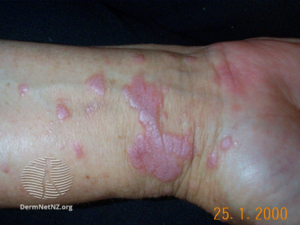Lichen Planus: a brief summary.
Lichen Planus is a chronic disorder that can present with a variety of dermatological manifestations. There are many clinical types of Lichen Planus which are based on the extent of involvement of different body parts, examples include Cutaneous, Mucosal and Nail Lichen Planus.
It is thought to be of an autoimmune etiology where the immune system attacks a protein within the skin and mucosal surfaces. Risk factors that may be involved include genetic predisposition, injury to the skin (Koebner’s Phenomenon) and skin diseases such as Herpes Zoster. Some drugs can induce a Lichenoid rash, examples include Quinine and Captopril.
Skin manifestations of Lichen Planus usually are in the form of papules and plaques. The plaques are crossed by fine white lines called Wickham’s striae. Lichen planus can occur anywhere on the skin but common sites include the wrists, ankles and the lower back. The plaques usually resolve after many months.
The diagnosis of Lichen Planus is usually clinical. In cases of diagnostic uncertainty, a skin biopsy may be needed to rule out competing diagnoses.
Mild Lichen Planus is usually treated with topical medications like steroids, calcineurin inhibitors and retinoids. More severe local disease, or in widely distributed disease, oral steroids are needed. Other immuno-modulators may be combined with oral steroids to reduce the dose, examples include Methotrexate and Azathioprine.
Written by: Turki Alsehli, Medical Student


Leave a Reply
Want to join the discussion?Feel free to contribute!